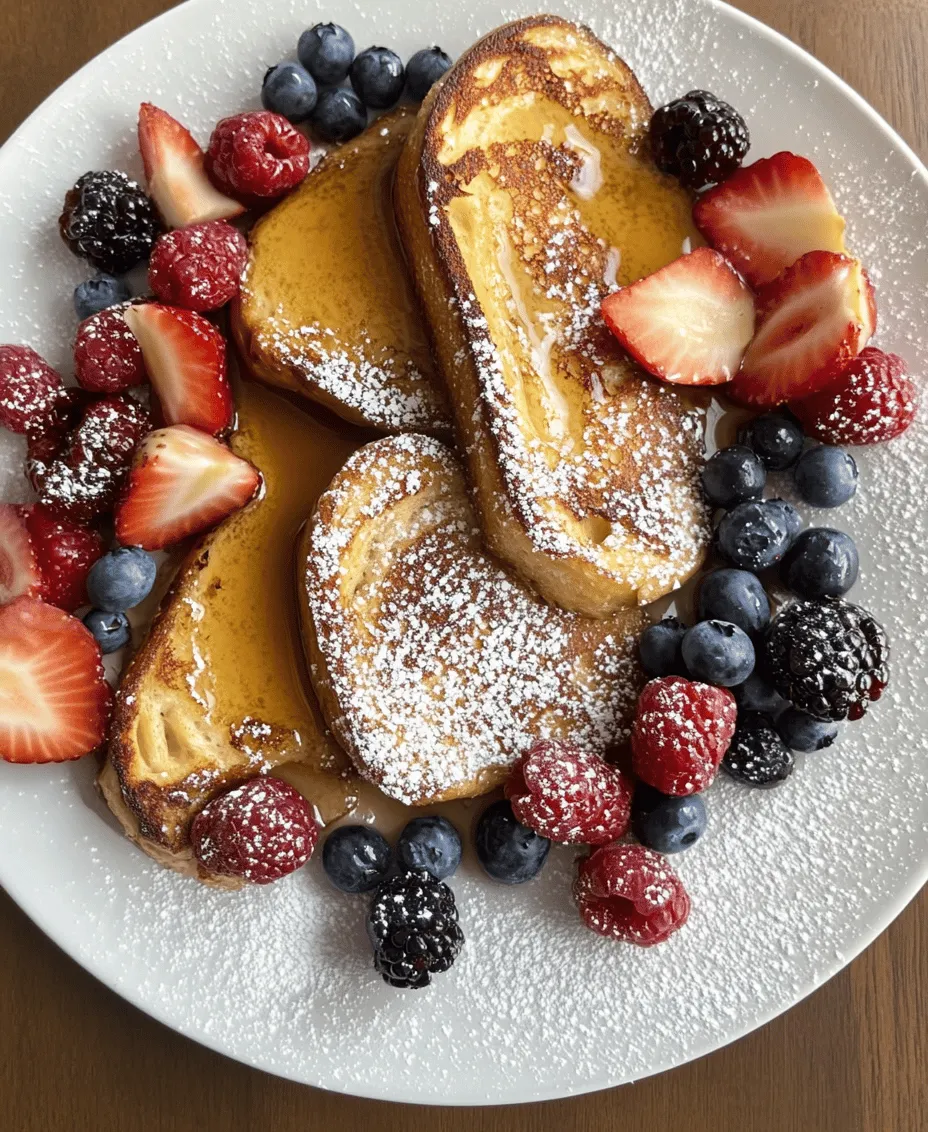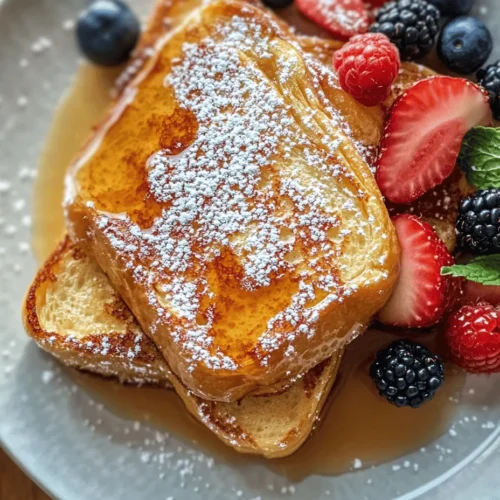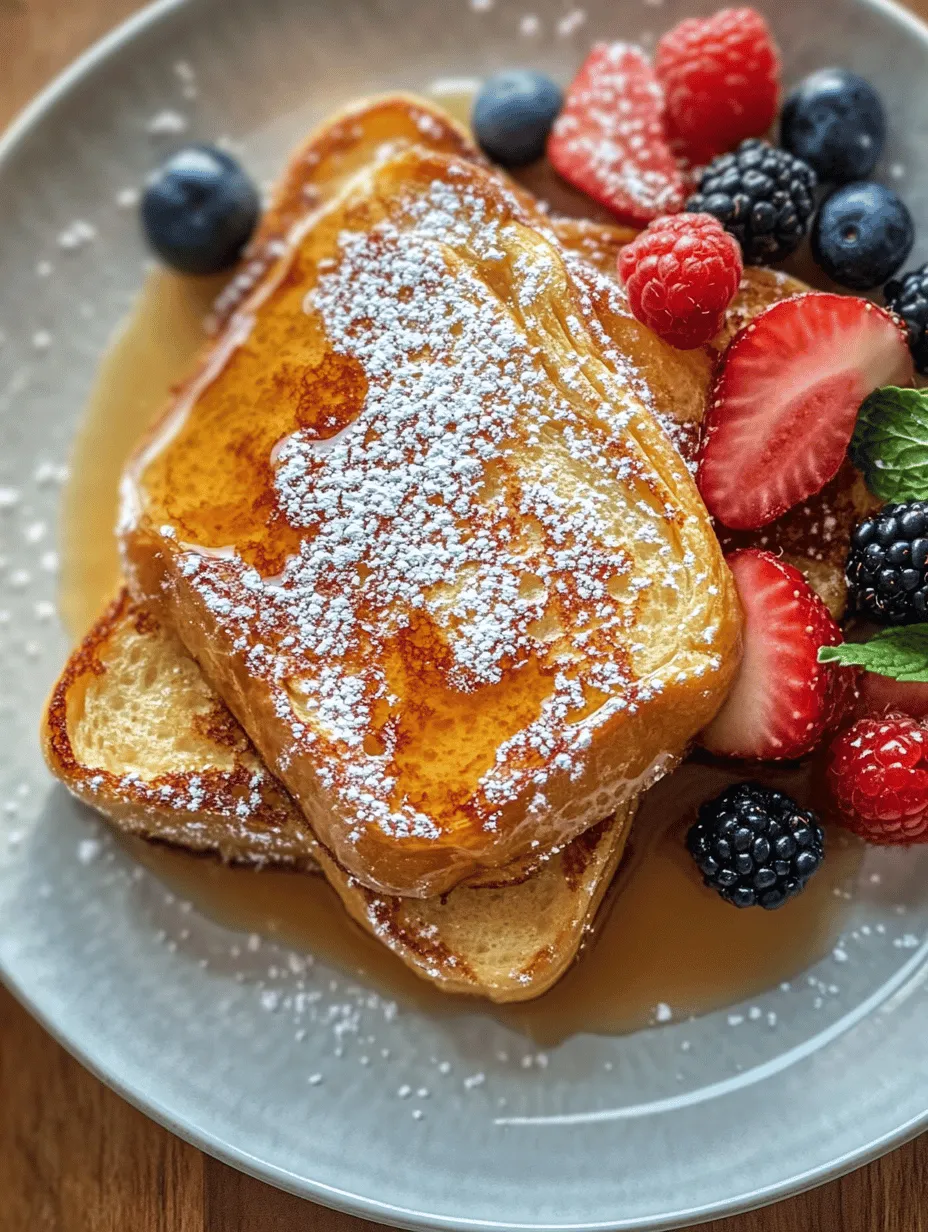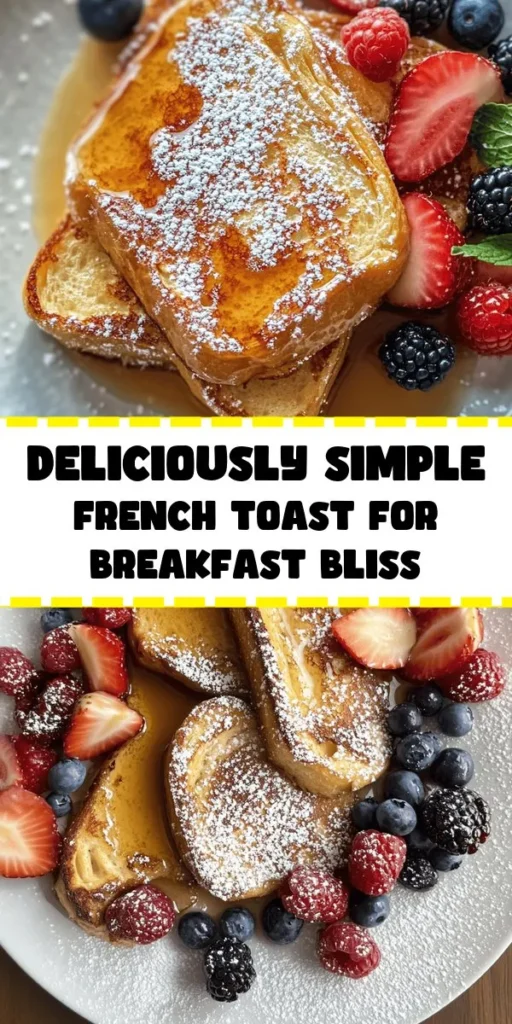Introduction
There’s something undeniably delightful about the simple pleasure of making French toast at home. This classic breakfast dish transforms humble ingredients into a warm, comforting meal that is both satisfying and versatile. Whether you’re preparing a cozy weekend brunch or a quick weekday breakfast, French toast offers a delightful way to start your day. With its crispy edges, fluffy center, and the sweet aroma that fills your kitchen, it’s no wonder that French toast has become a beloved staple in households around the world.
One of the key factors in achieving the perfect French toast lies in using quality ingredients. The right combination of bread, eggs, and milk can elevate this dish from ordinary to extraordinary. By focusing on the quality of each component, you can ensure that every bite is packed with flavor and texture, setting the stage for a truly heavenly breakfast experience.
This recipe for basic French toast is not only simple but also quick to prepare. With just a handful of ingredients and minimal prep time, you can whip up this delightful dish in no time. Whether you enjoy it topped with fresh fruit, a drizzle of maple syrup, or a sprinkle of powdered sugar, this French toast recipe is sure to become a favorite in your home.
Understanding French Toast
The origins of French toast date back thousands of years, with roots that can be traced to ancient civilizations. The concept of soaking bread in a mixture of eggs and milk to create a different texture and flavor has appeared in various cultures throughout history. The name “French toast” itself is believed to have originated in 17th-century England, where it was known as “eggy bread,” before being popularized in America as “French toast.”
Across different cultures, variations of French toast can be found. In Spain, it is known as “torrijas,” often flavored with cinnamon and served during Lent. In France, it is called “pain perdu,” meaning “lost bread,” as it was traditionally made with stale bread that would otherwise go to waste. Each variation highlights the cultural significance of using simple ingredients to create something delicious and comforting.
When it comes to making French toast, the choice of bread plays a crucial role in determining the dish’s final texture and flavor. While traditional recipes often call for white bread, there are many types of bread suitable for this dish. Brioche, with its rich, buttery flavor, lends a delicious sweetness and tenderness to French toast, while Texas toast, known for its thick slices, provides a hearty base that holds up well during cooking. Even sourdough or whole grain bread can work beautifully, adding unique flavors and textures to the dish.
Ingredients Breakdown
To create the perfect French toast, it’s essential to understand the role of each ingredient in the recipe:
Thick Bread
The foundation of any great French toast is the bread. Thick slices of bread are ideal for soaking up the egg mixture without falling apart during cooking. Brioche is a popular choice due to its soft, buttery texture and slightly sweet flavor, which enhances the overall dish. Alternatively, Texas toast, which is also thick and fluffy, provides a robust base that can absorb the custard mixture without losing its structure. Choosing a quality bread is essential, as it directly influences the taste and texture of your French toast.
Eggs
Eggs are a crucial component that helps bind the ingredients together and create a rich custard mixture. They contribute to the creamy texture and provide protein, making the dish more satisfying. The egg mixture also helps achieve that beautiful golden-brown crust when cooked, adding to the visual appeal. For best results, use large, fresh eggs, as they will have the best flavor and texture.
Whole Milk
Whole milk adds creaminess and richness to the custard mixture, enhancing the flavor of the French toast. It also helps to create a tender texture, making each bite melt in your mouth. While you can substitute with lower-fat milk or non-dairy alternatives, using whole milk will yield the most decadent results. The fat content in whole milk is essential for achieving that rich, custardy center that defines perfect French toast.
Vanilla Extract
Vanilla extract is a key ingredient that enhances the flavor profile of French toast. Just a splash of pure vanilla extract can elevate the taste, adding warmth and depth that complements the sweetness of the dish. It creates a fragrant aroma that fills the kitchen while cooking, making the experience even more enjoyable. Always opt for pure vanilla extract over imitation for the best flavor.
Ground Cinnamon
While ground cinnamon is optional, it adds an aromatic warmth and depth to your French toast. A sprinkle of cinnamon in the custard mixture or as a garnish can elevate the dish, giving it a cozy, comforting vibe. Cinnamon pairs beautifully with both sweet and savory toppings, making it a versatile addition to your French toast routine.
Unsalted Butter
Butter is essential for cooking French toast. It not only prevents sticking but also contributes to the flavor and helps achieve that coveted crispy crust. Using unsalted butter allows you to control the salt content in your dish, ensuring that the flavors are balanced. As the butter melts in the skillet, it creates a rich, golden surface on the French toast that enhances both its appearance and taste.
Maple Syrup and Garnishes
Finally, no French toast is complete without a drizzle of maple syrup. This classic topping adds sweetness and a delightful contrast to the rich custard flavor. You can also experiment with other garnishes, such as fresh fruit, whipped cream, or a dusting of powdered sugar, to add visual appeal and additional flavor. These finishing touches not only enhance the taste but also make your French toast presentation-worthy for any occasion.
By carefully selecting high-quality ingredients and understanding their roles in the recipe, you are setting yourself up for success in creating heavenly basic French toast. The balance of flavors and textures achieved through this simple recipe will undoubtedly leave your taste buds satisfied and eager for more. Now that you have a deeper understanding of the ingredients and their significance, let’s move on to the preparation and cooking steps that will bring your French toast to life.

Step-by-Step Instructions
Creating the perfect French toast is an art and a joy that anyone can master. Follow these detailed steps to ensure your Heavenly Basic French Toast turns out delicious every time.
Whisking the Egg Mixture: Achieving the Perfect Blend
Start by cracking the eggs into a medium-sized bowl. For a richer flavor, you can use large eggs, ideally at room temperature. Add in the milk, vanilla extract, cinnamon, and a pinch of salt. Using a whisk, combine the ingredients thoroughly until the mixture is smooth and uniformly blended. The key here is to incorporate air while whisking, which helps create a fluffy texture when cooked. If you desire a sweeter taste, consider adding a tablespoon of sugar or a dash of maple syrup to the egg mixture; this will enhance the overall flavor profile of your French toast.
Preheating the Skillet: Importance of Temperature Control
While you’re blending the egg mixture, it’s time to preheat your skillet or griddle. Set it to medium heat and allow it to warm up for about 3-5 minutes. A well-heated skillet is crucial for achieving that beautiful golden-brown crust. To check if your skillet is ready, you can sprinkle a few drops of water onto the surface; if they sizzle and evaporate quickly, you’re good to go. Using a non-stick skillet or adding a small amount of butter or oil will help ensure that your French toast doesn’t stick and cooks evenly.
Dipping and Cooking the Bread: Techniques for Perfect Texture
Now comes the fun part—dipping the bread! Take your slices of bread and submerge them in the egg mixture, allowing each side to soak for about 10-15 seconds. The goal is to coat the bread thoroughly without making it overly soggy. If you’re using thicker slices, like brioche or challah, you might want to let them soak a bit longer for optimal flavor absorption.
Once the bread is coated, carefully place it on the skillet. Cook each slice for about 3-4 minutes on one side until it’s golden brown, then flip and cook for another 3-4 minutes on the other side. Be sure to adjust the heat if you notice that the bread is cooking too quickly or not browning enough. Keep an eye on the slices to prevent burning, ensuring they develop a perfectly crispy exterior and a soft, custardy interior.
Tips for Serving: Best Practices for Plating and Garnishing
After cooking, transfer your French toast to a warm plate, or place it in a low oven (around 200°F) to keep it warm while you finish cooking the remaining slices. For an elegant presentation, stack two or three slices and dust them with powdered sugar. You can also garnish with fresh fruits such as strawberries, blueberries, or banana slices, which add a pop of color and natural sweetness. A drizzle of maple syrup or honey on top will elevate the dish even further, making it a delightful breakfast or brunch option.
Tips for Perfect French Toast
To ensure that your French toast is consistently excellent, consider these expert tips:
Insights on Selecting the Best Bread for Texture and Flavor
Choosing the right bread is crucial for achieving an exceptional French toast. Opt for bread that is slightly stale or day-old, as it absorbs the egg mixture better without falling apart. Brioche, challah, or even sourdough are excellent choices due to their density and flavor. Avoid using regular sandwich bread, as it can become too soggy and lose its shape during cooking. If you prefer a lighter option, whole grain bread can also work well, providing a nutty flavor and added nutrients.
Understanding the Right Cooking Temperature to Avoid Burning
Temperature control is vital for perfect French toast. Medium heat is generally the best setting, but this may vary depending on your stove. Always adjust the heat if you notice the toast is browning too quickly or not cooking through. If you’re making multiple batches, you may need to lower the heat slightly after the first few slices to prevent burning. A good tip is to test a single slice first—this will help you gauge the right temperature for the rest of your batch.
Variations in Serving: Exploring Different Toppings and Sides
French toast is incredibly versatile, allowing you to customize it to your taste. Beyond the classic maple syrup, consider experimenting with toppings like whipped cream, chocolate sauce, or yogurt. Fresh fruit compotes or nut butter can add delicious flavors too. For a savory twist, you can even serve your French toast topped with crispy bacon or a poached egg. Pair your French toast with sides like crispy hash browns or a light salad to create a well-rounded meal.
How to Store Leftovers and Reheat Effectively
If you have any leftovers, you can store them in an airtight container in the refrigerator for up to three days. To reheat, place the slices in a toaster or a toaster oven for a few minutes until warmed through. Alternatively, you can use a skillet over low heat, flipping occasionally to ensure even heating. Avoid microwaving, as this can make the bread chewy.
Health and Nutritional Insights
While French toast is often seen as an indulgent treat, there are ways to enjoy it while keeping health in mind.
Nutritional Benefits of the Ingredients Used in the Recipe
The primary ingredients of French toast—eggs and milk—are excellent sources of protein, providing essential amino acids that are important for muscle repair and growth. Eggs also contain vitamins such as B12, which is vital for nerve function and red blood cell production. Whole grain versions of bread can boost your fiber intake, aiding digestion and promoting a feeling of fullness.
Potential Modifications for Dietary Preferences (e.g., Dairy-Free Options)
If you’re looking to make your French toast dairy-free, substitute regular milk with almond milk, oat milk, or any other plant-based alternative. For the eggs, consider using a flaxseed meal mixture (1 tablespoon of flaxseed meal mixed with 2.5 tablespoons of water, allowed to sit for a few minutes until it thickens) or a commercial egg replacer. This way, you can cater to different dietary preferences while still enjoying the deliciousness of French toast.
Balancing Indulgence with Nutrition
To balance indulgence with nutrition, consider topping your French toast with fresh fruits instead of sugary syrups. Fruits add natural sweetness, fiber, and vitamins without the added sugars. Additionally, you could lighten the batter by using fewer eggs or replacing some of the milk with a lower-calorie alternative. This approach allows you to enjoy a delightful dish while being mindful of your nutritional intake.
Conclusion
The Heavenly Basic French Toast recipe is a simple yet delightful dish that brings joy to breakfast or brunch. With straightforward ingredients and easy-to-follow instructions, you can create a meal that’s both satisfying and comforting. Don’t hesitate to experiment with variations, whether it’s trying different bread types or incorporating unique toppings—this recipe encourages creativity in the kitchen.
Sharing homemade French toast with family and friends is a wonderful way to create lasting memories around the table. Whether enjoyed on a leisurely weekend morning or served at a festive gathering, this dish is sure to impress. So gather your ingredients, follow the steps, and prepare to indulge in a deliciously satisfying experience. Happy cooking!



